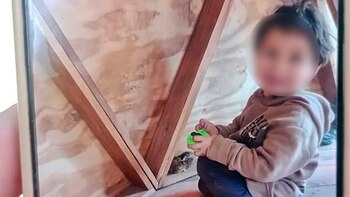After 362,000 kilometers traveled on five continents aboard a 1928 car, the Zapp family culminates in Argentina, their country, the traveling adventure that began 22 years ago, convinced that “humanity is wonderful”.
The city of Gualeguaychú, on the border of Argentina and Uruguay, is one of the last stops before arriving on Sunday at the Obelisk, the famous monument in the heart of Buenos Aires where Candelaria and Herman Zapp left on January 25, 2000. They return with four teenage children, born in different parts of the world.
“Feelings are very mixed. We are ending a dream or rather fulfilling a dream. The nice thing is to live it. What will come next? Thousands of changes, thousands of options,” Herman tells AFP who, at the age of 53, already dreams of going around the world, this time on a sailing boat.
Candelaria was 29 years old when they embarked on the journey. Now, at 51, he says that “everything was nicer than imagined. What we discovered was the people.”
“People are wonderful, humanity is incredible,” insists the woman who met 102 countries, despite the fact that once “a conflict or war forced us to divert the path”.
- The car “door opener” -
They had been married for six years and had “good jobs”. They had finished building their house on the outskirts of Buenos Aires, which will finally be the family home. They wanted children but first wanted to travel. Thus began a backpacking adventure to Alaska.
Someone offered them the 1928 car, a Graham-Paige, which was bad in engine and paint. “It didn't even start,” Candelaria evokes.
“The car doesn't have the best seats, nor the best cushioning, nor does it have air conditioning. It's a car that forces you to be alert. It doesn't seem comfortable but it was wonderful, it was a 'door opener', it was good for cities, for mud, for sand,” Herman enthuses.
In the age of 22 they only used eight sets of tires and made two engine openings.
“If I had a 4x4 zero kilometers, it would no longer exist, this one is more beautiful now than when it came out,” Herman excites as he unfolds up the tent that the car carries on its roof and where the four children sleep when it is their turn to camp.
On the road and with the first two children - Pampa, born in the United States, 19 years old, and Tehue born in Argentina, aged 16 - they enlarged the car. It was cut in half and added 40 centimeters and a seat.
So he was prepared for the arrival of Paloma, born 14 years ago in Canada, and Wallaby, in Australia 12 years ago.
Now Timon, the dog, and Hakuna, the cat, joined during a recent stay in Brazil, where they were stranded in 2020 by the covid pandemic.
From the roof, a tarp falls that gives them privacy inside the vehicle, where the parents sleep. They carry the trunk as a cooker and in the engine they can cook eggs and sausages or heat water. Clothes and utensils are stored under the seats. As if it were a snail, the old car served for many years as a family home.
“It's a small house but with a huge garden, with beaches, mountains, lakes. If you don't like the scenery, you can change it,” Herman jokes. The bodywork reads: “A family traveling around the world”.
In general, the Zapps stayed in homes. They estimate that there are 2,000 households that received them. “Humanity is incredible,” Candelaria enthuses about the solidarity received. “Many helped us just because we were part of a dream.”
But it wasn't all roses. During the trip Herman contracted malaria, they crossed Asia when there was avian flu, Africa with Ebola, Central America with dengue.
“We got out of a covid, we entered into an immense war, if we wait for the right moment, there will always be a reason not to fulfill our dreams,” says Herman.
- Argentines like Messi and the pope -
On the streets of Gualeguaychú, horns greet the passage of Graham-Paige. Fans of vintage cars come in wonder to take a picture. Some buy a copy of the book “Catching a Dream”, in which the Zapps tell about their experiences. With 100,000 copies sold so far, it is their main source of income, they say.
Other “door openers” around the world were star Lionel Messi and Pope Francis, because they were Argentines, like them. They even went to visit them to thank them and bring them their book.
It all started as a six-month journey, without cell phones or GPS, and only $4,000 saved. It took four years and a son to arrive in Alaska, they returned by boat to Argentina and toured the country. Afterwards followed Africa, Oceania, Asia and Europe.
They touched Mount Everest, tried balut (fertilized duck egg) in Asia, danced with the himba in Namibia, entered the tomb of Tutankhamun in Egypt, sailed many seas.
For the children, it was a direct experience that completed distance school and mother's classes. In Argentina, the face-to-face school awaits them.
“What I want most is to make a lot of friends,” Paloma says.
ls/nn/rsr/dbh
Últimas Noticias
Debanhi Escobar: they secured the motel where she was found lifeless in a cistern

The oldest person in the world died at the age of 119

Macabre find in CDMX: they left a body bagged and tied in a taxi
The eagles of America will face Manchester City in a duel of legends. Here are the details

Why is it good to bring dogs out to know the world when they are puppies




